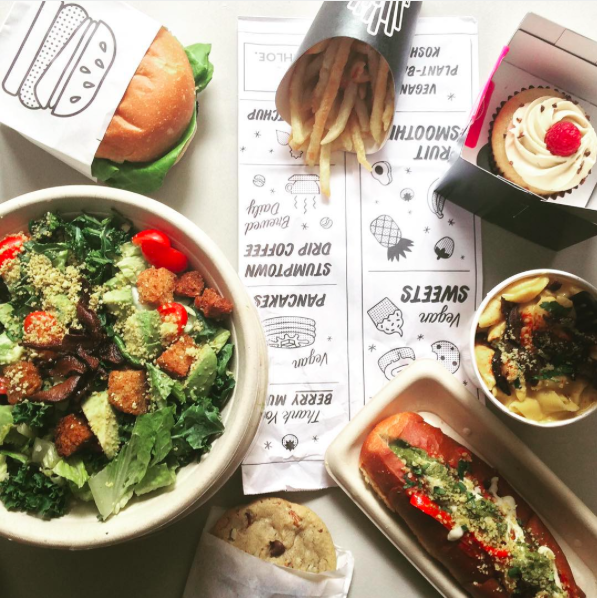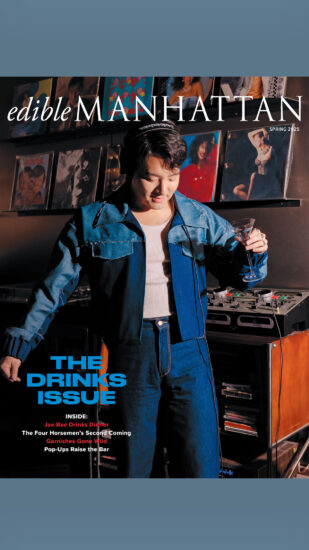https://www.instagram.com/p/BFPFZJzwf7G/
ICRAVE got it’s name and start before the iPhone. Their founder Lionel Ohayon actually thought up the name in college, envisioning the “i” as an “eye” and the “c” in “crave” is a copyright, which speaks to the integrity of the brand. But much like similarly named Apple products, ICRAVE used technology and human experience to design innovative spaces. They range from nightlife, restaurants and dining spaces to their newest addition of healthcare client Memorial Sloan Kettering. They’re also designing our space at Food Loves Tech.
We sat down with Leah, the company’s managing director, and Mariela, a senior designer, to discuss how they got to ICRAVE and the space they’re creating for us at Food Loves Tech on June 10-12 (get your tickets here!)
Edible Manhattan: How did you both get started with ICRAVE?
Mariela: I’ve been here for four years, working more on the concept pitch projects. One of the biggest projects I’ve overseen is Le District, which is sort of ten restaurants in one at a space in the Financial District. It was a really interesting and challenging to create multiple experiences within one space. In a previous life, I was a college professor.
Leah: What Mariela forgot to mention is that in her spare time, she runs a blog called “Tasty Plan,” which is a huge reason why we wanted her on the Food Loves Tech project. As for me, I’ve been working with ICRAVE for ten years as the managing director. Prior to that, I worked in the restaurant industry with Samba Brands. Our team has a clear love of food, both personally and professionally, which really contributes to our creative process when designing a space.
https://www.instagram.com/p/BA2x7KuQf0J/
EM: Tell me a little more about the ICRAVE studio itself.
L: What sets us apart is that we are an innovation and design studio, compared to a classic interior design studio. We push into other disciplines, such as technology, so our approach is very holistic when imagining a space. It’s not only the human experience but how technology and other additions elevate that experience. Our approach is different in that when a brand hires us, we want to break the mold and help reinvent or reinvigorate them. We are always talking to clients about what experience they want to create because it will ultimately become symbolic of their brand,
EM: As for technology, what are some of the more interesting projects you’ve accomplished?
L: Have you been to the Delta terminals at LaGuardia and seen the iPad stations? That’s our design. We worked with OTG management, the retail operator at the airport, for seven years to reinvent the modern airport and gate experience. Tech was really important to that redesign, not just for the sake of using technology, but to make the process easier and calmer.
M: The whole experience of going to an airport is stressful, so the little touches in design elements within the airport reduce stress and anxiety. For instance, being able to charge your phone easily or have an iPad full of games to entertain yourself or your children have a calming presence over travelers.
L: After we worked with OTG, we signed on more airport clients. Every operator thinks a little bit differently. But the central theme is that integrating technology is not meant to take away from the human experience but add value to it. There’s still a need for excellent hospitality, but technology allows the people working in the airport to focus on more important things.
https://www.instagram.com/p/BDWeTkWQf__/
EM: Without giving too many secrets away, can you talk about the concept for the Food Loves Tech?
M: At first, everything was very loose and up in the air. We were throwing out all sorts of ideas. Then we began working with the different teams involved with putting the event together to craft a story that ties together all the different ideas. Our main goal is to inspire curiosity and offer a different experience for everyone who walks through. The space the event is held in is a tunnel. So there’s a really interesting opportunity to tell a story through this long pathway. Rather than a traditional food tasting event where you’re going from vendor to vendor, this event is designed as a journey.
L: And because it’s the first year of the event, we’re focused on creating a brand that can live on year to year. There will be clear branded elements over the year but the experience and design will be malleable, so as to evolve as the technology featured evolves over the years.
EM: This idea reminds me a lot of the children’s science museum I went to each year with my class.
L: Exactly! It’s not about celebrity chefs promoting their newest product or restaurant. We actually asked the question why do science museums end in the fifth great and why can’t adults have something like that where they can learn, that’s hands-on and memorable. So we created our own version of a hip and quirky science museum for adults.
EM: Speaking more to actual products and innovation that will be showcased, how will the different experiences work together?
M: We are creating a journey of where we’re all going together; it’s going to bring awareness. For instance 3D food has been going along for a while and having that featured alongside growing mushrooms indoors will be cool. The way we are bringing all these things together will tell a compelling story.



